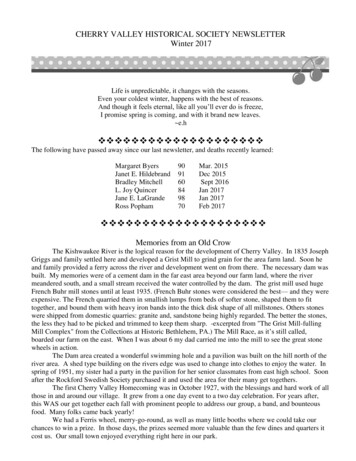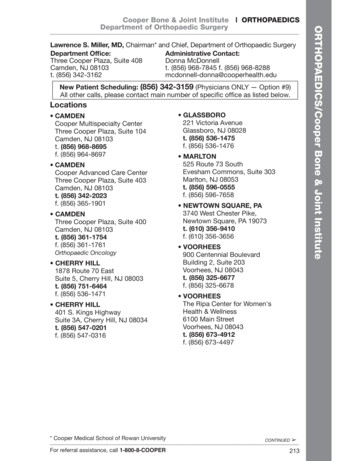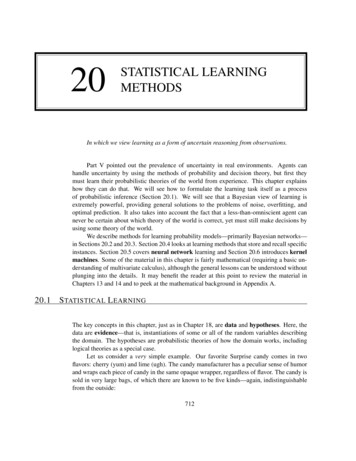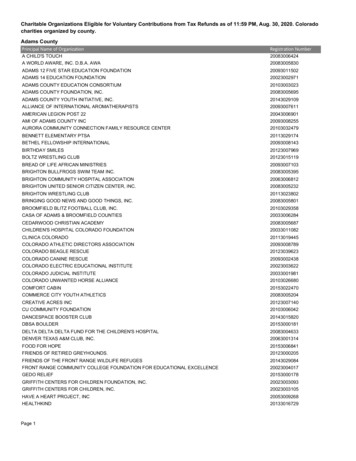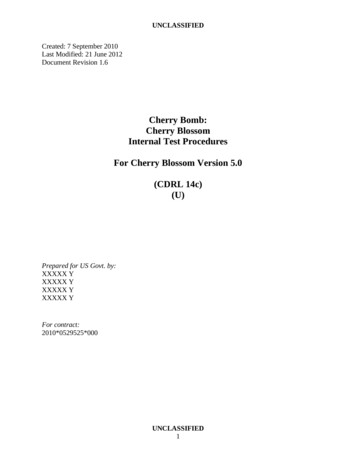
Transcription
UNCLASSIFIEDCreated: 7 September 2010Last Modified: 21 June 2012Document Revision 1.6Cherry Bomb:Cherry BlossomInternal Test ProceduresFor Cherry Blossom Version 5.0(CDRL 14c)(U)Prepared for US Govt. by:XXXXX YXXXXX YXXXXX YXXXXX YFor contract:2010*0529525*000UNCLASSIFIED1
UNCLASSIFIEDRevisionsVersionDescription of VersionDate Completed1.0Initial draft – derived from Cherry Blossom System FAT Procedures(CDRL 14)7 September 20101.1Updated email/chat info21 October 20101.2Added section 4.2.x tests for CB v4 requirements. Removedredundant 5.7 test.3 November 20101.3Added start and stop CT services to delete flytrap test.2 December 20101.4Removed deprecated and redundant tests.15 December 20101.5Added CB v5.0 info6 March 20121.6Added additional CB v5.0 tests for persistent target actions21 June 2012UNCLASSIFIED2
UNCLASSIFIEDCherry Bomb ProgramCherry Blossom Internal Test ProceduresTable of Contents1 Introduction.71.1 Purpose.71.2 Program Overview.71.3 Points of Contact.81.4 Applicable Documents.81.5 Conventions.91.6 Prerequisites.91.7 Test Types.92 Unit Tests.102.1 CherryTree/Web Unit Tests.102.2 Flytrap Unit Tests.102.3 Flytrap Device Unit Tests.103 Automated System Tests.123.1 Generic Filter Test.123.2 Memory and File Descriptor Leaks Test .134 Flytrap Tests.144.1 Beacon Tests.144.1.1 Initial Beacon (IB) Period Test.154.1.2 IB Traffic Requirement Test.164.1.3 IB Fast/Slow Retry Test.164.1.4 IB Traffic Requirement Timeout Test.174.1.5 IB Internet Connectivity Test.174.1.6 IB Suicide Time Test.174.1.7 Power-Cycle Beacon Test.184.1.8 Periodic Beacon (PB) Interval Test.184.1.9 PB Traffic Requirement Test.194.1.10 PB Traffic Requirement Timeout Test.194.1.11 PB Internet Connectivity Test.194.1.12 PB Fast/Slow Retry Test.204.1.13 Overnight PB Test.204.1.14 PB Suicide Time Test.214.1.15 Date Change Immunity Test.214.1.16 Ontime Consistency Through Power-Cycles Test.214.2 Flytrap Features.224.2.1 Email/Chat Target Detection/Alerting Test.224.2.2 MAC Target Detection/Alerting Test.244.2.3 Beacon Status and Security Settings Test.254.2.4 Alert Caching Test.254.2.5 Target Monitoring Test.264.2.6 Redirect Action Test.264.2.7 Double IFrame Action Test.264.2.8 Copy Action Test.274.2.9 Derived MAC Detection/Alerting Test.284.2.10 Email/Chat Target Action Inheritance Test.28UNCLASSIFIED3
UNCLASSIFIEDCherry Bomb ProgramCherry Blossom Internal Test Procedures4.2.11 MAC Target Actions Test.294.2.12 MAC Target Action Inheritance (Lack Thereof) Test.294.2.13 Copy All Test.304.2.14 Harvest Test.304.2.15 Flytrap Kill Test.304.2.16 Minimal Device Resource Usage Test.314.2.17 Minimal Interference with Normal Device Usage Test.314.2.18 Max Targets & Max Actions Test.314.2.19 Encrypted Comm Test.324.2.20 Port/Protocol Scanning Tests.324.2.21 Firmware Upgrade Inhibit Test.334.2.22 Mission Manager NVRAM Reset Test.334.2.23 Throughput Degradation Test.344.2.24 Erasure of Persistent Data After Flytrap Upgrade Test.344.2.25 No Flytrap Persistent Data in Device Config File Test.354.2.26 No Unintended Emissions Test.354.2.27 Target Based VPN Link Action Test.354.2.28 Target Based VPN Proxy Action Test.364.2.29 VPN Link Global Action Test.364.2.30 VPN Proxy All Global Action Test.374.2.31 Squid Proxy Beacon Test.374.2.32 Squid Proxy Alert Test.374.2.33 Squid Proxy Copy Test.384.2.34 Squid Proxy Copy Content-Length Filter Test.384.2.35 Copy Content-Length Reset Test.394.2.36 W Alert Test.404.2.37 Application Execution Test.404.2.38 Inhibit FW Version String Test.404.2.39 Upgrade Alert Test.414.3 S/E 3xxx Specific Tests.414.3.1 S/E 3xxx Operational Modes Test.414.3.2 S/E 3xxx Wireless Settings Test.434.3.3 S/E 3xxx Default Gateway Discovery (DGD) Test.444.4 CB Version 5.0 Specific Tests.46This section describes CherryBlossom tests related to the Version 5.0 release.464.4.1 Exclude/Include Built-in Beacon Addresses.464.4.2 No Windex Server Connection Links.464.4.3 Run OWT From Cherry Web.464.4.4 Sort Flytraps by Most Recent Beacon.474.4.5 Search Target Decks for Targets.474.4.6 Target Deck Action Initial Persistence Into Planned Missions.474.4.7 Edited Target Deck Action Persistence Into Planned Missions.484.4.8 Edited Target Deck Action Persistence Into Active Missions.484.4.9 Transparency of Auto-generated Missions.495 Cherry Tree Tests.49UNCLASSIFIED4
UNCLASSIFIEDCherry Bomb ProgramCherry Blossom Internal Test Procedures5.1 CW Login Test.505.2 CW Ticker Test.505.3 CW Overview Test.505.4 CW View- Alerts Test.515.5 CW View- Target Activity/Target Details Test.515.6 CW View- Flytraps Test.515.7 CW View- Flytraps- Diagnostic Test.525.8 CW Flytrap Details Test.525.9 CW View- Flytraps- Deployments Test.525.10 CW View- Missions Test.525.11 CW Mission Details Test.535.12 CW View- Copy Data Test.535.13 CW View- Harvest Data Test.535.14 CW View- VPN Data.535.15 CW Plan- Targets Test.545.16 CW Plan- Exploits- Windex Test.545.17 CW Plan- Exploits- VPN Link/Proxies Test.545.18 CW Plan- Tumbleweeds Test.555.19 CW Plan- Missions -- Creation Test.555.20 CW Plan- Missions -- Edit Test.565.21 CW Plan- Missions -- Default Test.565.22 CW Plan- Missions -- Archive Test.565.23 CW Plan- Flytraps – Create Test.575.24 CW Assign- Missions to Flytraps Test.575.25 CW Assign- Kill Test.585.26 CW Flytrap Details: Strict Buffer Fill Percent Test.585.27 CW Flytrap Details: RFC822 Buffer Fill Percent Test.585.28 CW Administer- Users -- Add Test.595.29 CW Administer- Users -- Edit Test.595.30 CW Administer- Users -- Delete Test.605.31 CW Administer- Customers -- Add Test.605.32 CW Administer- Permissions Test.605.33 CW Administer- Password Test.615.34 CW Plan- Missions Permissions Test.615.35 CW Plan- Flytraps – Edit Test.615.36 CW Plan- Target Decks – Creation Test.625.37 CW Plan- Target Decks – Edit Test.625.38 CW Plan- Target Decks – Archive Test.635.39 CW Customer Display Filter Test.635.40 One Way Transfer (OWT) – Directory Structure Test.635.41 One Way Transfer (OWT) – Invalid Customer Test.645.42 One Way Transfer (OWT) General Test.645.43 CW Random Link Walk Test.655.44 CW Multiple Target Decks Exceeding 150 Targets in a Mission Test.655.45 CW Catapult (Simulated) Test.65UNCLASSIFIED5
UNCLASSIFIEDCherry Bomb ProgramCherry Blossom Internal Test Procedures5.46 Delete Flytrap from the CherryTree Database.675.47 Prune Flytrap Security Information.675.48 Validate Authentication Logging.685.49 Power Cycle Test.685.50 Status Alert Pruning.696 Extended/Periodic Time Tests.706.1 Quick Periodic Test.706.2 System Logs Inspection.707 Upgrade Tests.717.1 LAN Upgrade Test.717.2 WLAN (Wireless) Upgrade Test.717.3 WAN Upgrade Test.71UNCLASSIFIED6
UNCLASSIFIEDCherry Bomb ProgramCherry Blossom Internal Test Procedures1 Introduction1.1 PurposeThis document describes the internal test procedures for the Cherry Blossom project ofthe Cherry Bomb program. These tests are performed internally by the contractor inpreparation for FAT. These tests are performed to test fine-grained functionality of theCherry Blossom system deemed too time-consuming and/or labor-intensive for FAT.This document should be used in conjunction with the Cherry Blossom InternalVerification and Validation Report (CDRL 15-c) -- referred to as VVR hereafter. Whenrunning the tests described in this document, update VVR with appropriatedate/tester/version/pass-fail information. Test numbers in this document map to those inVVR. Note that this document derives from the “TestProcedures.doc” of the CherryBlossom project.For further context, see the Cherry Bomb Quality Assurance Plan (CDRL 3).1.2 Program OverviewThe CBomb program (contract end 31 August 2012) is a follow-on to the CherryBlossom project (contract ended 28 February 2010). CBomb encompasses the priorCherry Blossom project work and specifically partitions Claymore work (which wasstarted on the prior Cherry Blossom contract) into a separate project.Figure 1 shows the CBomb program/project/product hierarchy.UNCLASSIFIED7
UNCLASSIFIEDCherry Bomb ProgramCherry Blossom Internal Test herry BlossomCherry TreeCherry BombMobile SystemClaymoreFixed SystemFigure 1: Cherry Bomb Product HierarchyThe CBomb program consists of two major projects, Cherry Blossom (CBlossom) andClaymore. The CBlossom project has three major products, a frontend “Flytrap”, a“Sunflower” development kit, and a backend “Cherry Tree”. Note that Sunflower is ajoint effort with another contractor, referred to hereafter as the Sunflower OtherContractor (SOC). The Claymore project also has two major products, a “Mobile”system and a “Fixed” system.1.3 Points of ContactPoints of contact for the CBomb project include: XXXXX – sponsor – COTR XXXXX Y – contractor – PM XXXXX Y – contractor – Lead Engineer1.4 Applicable DocumentsThe following table shows related documents: Cherry Bomb Contract Cherry Bomb Statement of Work Cherry Bomb Quality Assurance Plan (CDRL-3) Cherry Bomb: Cherry Blossom User’s Manual (CDRL-12) Cherry Bomb: Cherry Blossom System Test Plan (CDRL-13)UNCLASSIFIED8
UNCLASSIFIEDCherry Bomb ProgramCherry Blossom Internal Test Procedures1.5 ConventionsThe documentation for each individual test contains: Description – a short description of the testContext – (optional). If the test requires additional lengthy contextual information,include it here.Setup – procedures for setting up the test.Run – procedures for running the test.Pass/Fail – description of how to determine if a test passed or failedAll test devices have the default LAN IP address and username/password labeled onthe device. Most devices also have a reset button or similar that if depressed for 15seconds or so will reset the device to the manufacturer defaults. If you are havingtrouble connecting/pinging a device, use the reset button, and then use the info labeledon the device to connect/configure.1.6 PrerequisitesTo perform the procedures in this document, the tester needs a working knowledge ofthe Cherry Blossom system. It is assumed that the tester has read the Cherry BlossomUser’s Manual in enough detail to understand the various Cherry Blossom features andlogic/design of those features. The tester must also have a working knowledge ofwireless 802.11 networks, including how to configure 802.11 routers/AP’s, and how toconnect wireless clients to wireless networks.1.7 Test TypesThis section describes the test types in this document. Each test type is partitioned intoa separate section. The following test types are: Unit Tests (section 2) – automated tests that exercise individual softwaremodules/libraries/classes/methods. Automated System Tests (section 3) – automated (i.e., no operator required) tests thatexercise the system as a whole. Product Specific Tests (Flytrap section 4, Cherry Tree section 4.4) – tests specific to aparticular product Periodic/Extended Time Tests (section 6) – tests to ensure robust system operation overan extended period of time. Upgrade Tests (section 7) – related to Flytrap upgrades.UNCLASSIFIED9
UNCLASSIFIEDCherry Bomb ProgramCherry Blossom Internal Test Procedures2 Unit TestsThis section describes unit tests for the Cherry Blossom system.2.1 CherryTree/Web Unit TestsDescription: these unit tests exercise the software libraries, classes, interfaces,etc. of the backend CherryTree/Web softwareSetup: checkout (or update) the latest version of CherryBlossom software fromthe subversion repository (“ CB ” refers to the root directory of this checkout).Run: cd CB /CherryTree && ant testPass/Fail: any unit test failures will stop the test process and report the error;otherwise success will be reported.2.2 Flytrap Unit TestsDescription: these unit tests exercise the software libraries, classes, interfaces,etc. of the front-end Flytrap software (MissionManager and GenericFilter).Setup: checkout (or update) the latest version of CherryBlossom software fromthe subversion repository (“ CB ” refers to the root directory of this checkout).Run: cd CB /Flytrap && make test clean && make test inc && make testPass/Fail: any unit test failures will stop the test process and report the error;otherwise success will be reported.2.3 Flytrap Device Unit TestsDescription: these unit tests exercise the software libraries, classes, interfaces, etc.of the frontend Flytrap software (MissionManager and GenericFilter). However,instead of running them on the client machine, they are run on the Flytrap.Setup: checkout (or update) the latest version of CherryBlossom software from thesubversion and build and re-image the flytrap. You should also be directlyconnected to the flytrap being tested.UNCLASSIFIED10
UNCLASSIFIEDCherry Bomb ProgramRun: Perform the following: Cherry Blossom Internal Test Procedurescd CB /Flytrapmake im{image number} inc && make target tests. For example,make im32 inc && make target tests.The image number can be found by searching for the appropriate MMV in the CB /Flytrap/formImage.sh file. Upload the mm T executable to the flytrap:From the flytrap, run ‘netcat -v -w 90 -l -p 5600 /tmp/mm T’From the client, run ‘cd CB /Flytrap/Apps/MissionManager/Test&& nc -v -w 10 {flytrap IP} 5600 mm T’ If any changes have been made to the underlying source code between thetime the flytrap was re-imaged and testing, upload the dynamic libraries to theflytrap. This is typically only necessary during a troubleshooting phase andnot during normal testing.From the flytrap, run ‘mkdir /tmp/ft-{svn.version}’ and then ‘netcat-v -w 90 -l -p 5600 /tmp/ft-{svn.version}/libft.so‘From the client, run ‘cd CB /Flytrap/Common/libft && nc -v -w10 {flytrap IP} 5600 libft.so’From the flytrap, run ‘netcat -v -w 90 -l -p 5600 /tmp/ft{svn. version}/libcbrypt.so‘From the client, run ‘cd CB /Flytrap/Common/libft && nc -v -w10 {flytrap IP} 5600 libcbcrypt.so’The ft-{svn.version} path is displayed at the end of the make call and canbe found by searching for ‘-rpath /tmp/ft-{svn.version}’ From the flytrap, run ‘chmod x /tmp/mm T’From the flytrap, run ‘/tmp/mm T’Pass/Fail: any unit test failures will stop the test process and report the error;otherwise success will be reported.UNCLASSIFIED11
UNCLASSIFIEDCherry Bomb ProgramCherry Blossom Internal Test Procedures3 Automated System TestsThis section describes automated system tests for the Cherry Blossom system.3.1 Generic Filter TestDescription: This test is performed to simulate an operational environment whichstresses the software under heavy load conditions. They may be run from thecommand line or from a script and provide "PASS/FAIL" output to indicate testresults.Setup: follow instructions in CB /Test/GenericFilter/README.htmlRun: CB /Test/GenericFilter/README.html . Perform the following: Generic Filter System Test: follow instructions in CB /Test/GenericFilter/README.html , which include a “Wireless ClientShort”, “Wired Client Short”, “Wireless Client Long”, and “Performance Test”.Ideally, this test is performed simultaneously on multiple Flytraps and clients.Generic Filter System Test in the presence of other client traffic: ping theFlytrap from a routable host, run the Performance Test on one test client, andrun the Generic Filter Test on a different client.Pass/Fail: the scripts used to run the various Generic Filter Tests will indicatepass/fail. The Performance Test has no hard requirement, although typically we liketo keep T1-like internet throughput degradation at 10%.UNCLASSIFIED12
UNCLASSIFIEDCherry Bomb ProgramCherry Blossom Internal Test Procedures3.2 Memory and File Descriptor Leaks TestDescription: Tests that Flytrap firmware is not causing memory and file descriptorsleaks after a significant stress test.Setup: same as Generic Filter Test (see 3.1). Power-cycle the Flytrap and afterabout 30 seconds, telnet to it and record the initial available memory (typically cat/proc/meminfo) and initial file descriptor usage (typically cat /proc/sys/fs/file-nr).Run: run 1000 iteration Generic Filter System Test (see 3.1). When this hascompleted, telnet to the Flytrap and record the available memory (typically cat/proc/meminfo) and file descriptor usage (typically cat /proc/sys/fs/file-nr).Pass/Fail: the test passes if there is no appreciable change in available memory andfile descriptor usage as a result of the 1000 iteration Generic Filter Test.UNCLASSIFIED13
UNCLASSIFIEDCherry Bomb ProgramCherry Blossom Internal Test Procedures4 Flytrap TestsThis section describes Cherry Blossom tests related to the Flytrap product.For testing purposes, the Flytraps will have telnet capabilities enabled. However, thefollowing devices do not support telnet: Belkin F5D8231-4For these devices ‘dumbbellc’ must be used. Dumbbellc is used to send commandsto the Flytrap and then redirects the output back to the user. To build dumbbellc, run‘ CB /Flytrap/make tools’ to create CB /Flytrap/Tools/bin/dumbbellc. Inaddition to the dumbbellc c
UNCLASSIFIED Revisions Version Description of Version Date Completed 1.0 Initial draft - derived from Cherry Blossom System FAT Procedures (CDRL 14)




